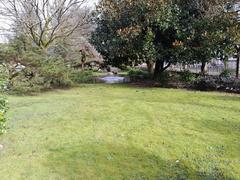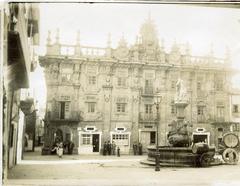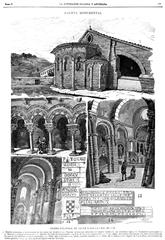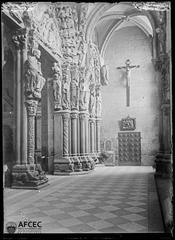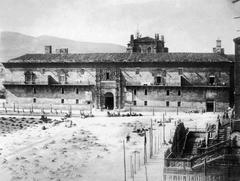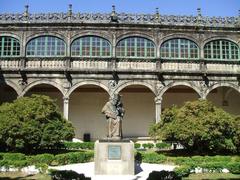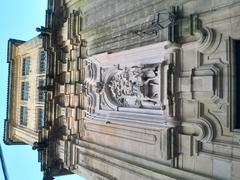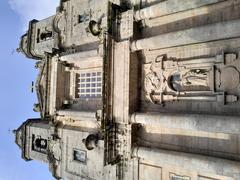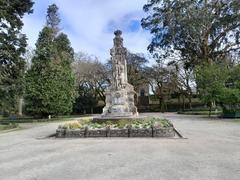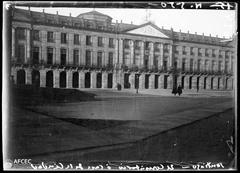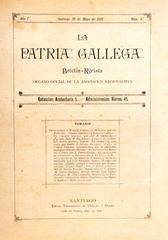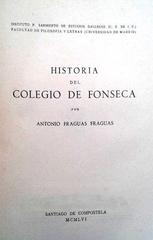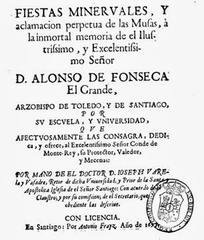Oak Grove of Santa Susana Santiago de Compostela: Visiting Hours, Tickets & Historical Sites Guide
Date: 03/07/2025
Introduction
Located atop a scenic hill in Santiago de Compostela’s historic Alameda Park, the Oak Grove of Santa Susana (Carballeira de Santa Susana) is one of Galicia’s most treasured natural and cultural landmarks. Home to more than 300 ancient oaks and adjacent to the Romanesque Church of Santa Susana, this site offers a unique blend of ecological richness, historical depth, and spiritual significance. Its roots reach back to a pre-Roman Iron Age castro, and over the centuries, the grove has evolved into a vibrant public space, central to local festivals, pilgrim traditions, and community life (Parque Forestal de Santiago; Santiago Turismo; Turismo de Galicia).
Whether you are a pilgrim finishing the Camino de Santiago, a history enthusiast, or a visitor seeking a tranquil green space, the Oak Grove of Santa Susana is a must-see destination. This guide presents a detailed overview of its history, features, accessibility, sustainable tourism practices, and practical tips for your visit (skyticket.com; cityseeker.com).
Historical and Cultural Significance
Early Origins and Archaeological Context
The Oak Grove stands on the site of a pre-Roman castro—an Iron Age hillfort—highlighting its ancient roots in Galicia’s history (Parque Forestal de Santiago; Galician Wikipedia). This location later became a focal point for religious and civic life.
Medieval Foundations: The Church and Relics
In 1102, Archbishop Diego Gelmírez founded the Church of Santa Susana to house the relics of Saint Susana, brought from Braga, Portugal (Santiago Turismo). The church, rebuilt in the 17th and 18th centuries, retains Romanesque and Gothic elements. It remains a spiritual center, especially during local festivals.
Civic and Environmental Legacy
In 1546, the Counts of Altamira donated the hill to the city, and local residents planted oaks, poplars, and ashes to restore the landscape (Galician Wikipedia). The grove became a civic meeting place and hosted the traditional Thursday livestock fair until the 1970s (Fundación Jacobea).
Urban Integration and Cultural Symbolism
The Oak Grove forms an integral part of Alameda Park, alongside the Paseo da Ferradura—a horseshoe-shaped promenade with panoramic views of the city and cathedral (Viajeray Mochilero). The area features monuments, sculptures, and hosts events like the annual Book Fair, contributing to its status as a cultural hub (Parque Forestal de Santiago).
Natural Features
The Oaks
The grove’s ancient Galician oaks (Quercus robur) are its central attraction, offering shade and a tranquil atmosphere. Some trees are over 200 years old, and their dense canopy creates a “natural cathedral” (skyticket.com).
Biodiversity
Beyond oaks, the park supports over 90 plant species, including chestnuts, laurels, and camellias, and is home to diverse birdlife, making it a hotspot for nature lovers and birdwatchers (skyticket.com).
Landscape and Accessibility
The Oak Grove sits at Alameda Park’s highest point, offering sweeping city views. Paved and gravel paths, some dating from the 16th century, make it accessible for walking, jogging, and cycling (Turismo de Galicia).
Architectural Highlights
Church of Santa Susana
This Romanesque church features a simple rectangular nave, semicircular apse, and a bell gable. The stone façade and interior altar are a testament to rural Galician church architecture (Turismo de Galicia).
Pathways and Monuments
Historic paths crisscross the grove, while nearby Alameda Park offers notable sculptures such as “Las Dos Marías” and commemorative fountains (thenwewalked.com).
Views
The Miradoiro da Catedral viewpoint provides iconic vistas of the cathedral and old town, especially striking at sunrise and sunset (thenwewalked.com).
Visiting Information
Hours and Tickets
- Grove & Park: Open daily, dawn until dusk, year-round; free entry.
- Church: Usually closed except for special religious events and festivals. Check local tourism offices for schedules.
Accessibility
- Paved paths are suitable for wheelchairs and strollers.
- Benches, shaded areas, and restrooms are available in Alameda Park.
- Public transport and parking are nearby.
Getting There
- By foot: 10–15 minute walk from the cathedral and old town.
- By public transport: Multiple bus lines serve the park area.
- By car: Limited nearby parking; city center lots recommended (cityseeker.com).
Best Times to Visit
- May–October: Mild weather and lush foliage.
- Spring (April–June): Blooming flowers.
- Autumn (September–October): Vibrant leaves and fewer crowds.
- Summer (July–August): Festivals and shade from the oaks.
- Winter (November–March): Quiet, peaceful atmosphere (best-time.to; whereandwhen.net).
Activities and Tips
What to Do
- Explore the grove’s trails and enjoy panoramic views.
- Visit the Church of Santa Susana during open hours or special events.
- Attend festivals, concerts, or cultural gatherings during the summer and on Saint James Day (July 25).
- Birdwatch or picnic beneath the ancient oaks.
What to Bring
- Comfortable walking shoes.
- Weather-appropriate clothing; rain gear in wet months.
- Camera or smartphone for photos.
- Picnic supplies (no cafés inside the grove).
Facilities
- Restrooms, benches, and playgrounds are available in Alameda Park.
- Cafés and restaurants offering Galician cuisine are just outside the park (best-time.to).
Etiquette
- Keep noise to a minimum, especially during religious events.
- Use marked paths to protect the environment.
- Dogs are welcome but must be leashed; owners must clean up after them.
- Respect the tranquility and spiritual atmosphere.
Sustainable Tourism and Conservation
Sustainable Practices
- The grove is maintained through collaborative city and community programs.
- Waste management and recycling bins are provided—visitors should leave no trace (Caminosantiago Compostela).
- Educational signage and guided tours foster environmental awareness (Fundación Jacobea).
- Visitors are encouraged to support local businesses and use public transport to reduce their carbon footprint (Wanderlust Magazine).
Conservation Challenges
- Ongoing volunteer and city-led efforts monitor and protect the ancient oaks in the face of high visitor numbers (Travel Infused Life).
- Special attention is given during festivals and peak tourist seasons to ensure minimal impact.
Frequently Asked Questions (FAQs)
Q: What are the visiting hours?
A: The Oak Grove is open daily from dawn until dusk, year-round. The Church of Santa Susana is open only during special events.
Q: Is there an entrance fee?
A: No, access to the grove and Alameda Park is free.
Q: Are guided tours available?
A: Yes, via local tour operators and the tourist office. Book in advance for group visits.
Q: Is the site accessible for people with disabilities?
A: Main paths are wheelchair and stroller friendly; the historic church may have limited access.
Q: Can I bring my dog?
A: Yes, dogs are welcome on leash.
Q: Are there restrooms?
A: Yes, public restrooms are available in Alameda Park.
Summary and Plan Your Visit
The Oak Grove of Santa Susana is a living testament to Santiago de Compostela’s layered history, local culture, and commitment to environmental stewardship. With free, year-round access and excellent amenities, it is a serene and enriching stop for all visitors. Experience its ancient oaks, Romanesque architecture, cultural events, and panoramic views—all within easy reach of Santiago’s historic center.
To make the most of your journey, use official tourism websites, download the Audiala app for guides and maps, and follow sustainable tourism practices to help preserve this cherished site (Fundación Jacobea; I Love Compostela; Wanderlust Magazine).
References
- Parque Forestal de Santiago
- Santiago Turismo
- Turismo de Galicia
- skyticket.com
- cityseeker.com
- Fundación Jacobea
- I Love Compostela
- Wanderlust Magazine
- best-time.to
- whereandwhen.net
- thenwewalked.com
- Caminosantiago Compostela
- Travel Infused Life
